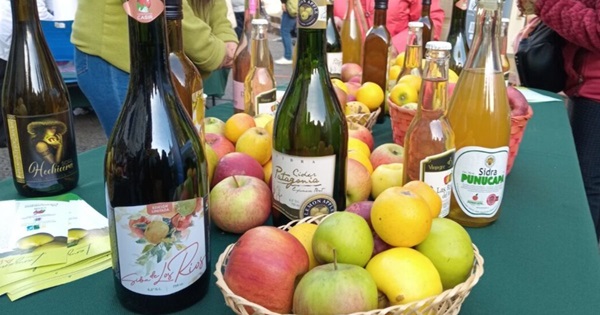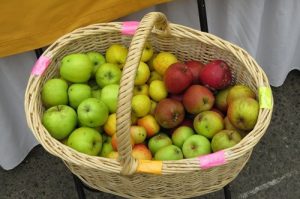This post is also available in:
Español
Português
Cider, a fermented beverage made from apples, has a long and rich history that intertwines with the introduction of apple trees (Malus domestica) to the Americas by the Spanish.

From the first colonial plantations to its current international recognition, Chilean cider has evolved to become a symbol of cultural identity and artisanal quality.
Contenido
The Arrival of Apples in the Americas
Manzana is not a fruit native to America. heir introduction occurred during European colonization, as settlers brought various plant species to ensure familiar sources of food and beverages.
Among these crops was the apple tree, whose adaptability allowed it to spread rapidly across the continent.
In Chile, the first apples arrived via Peru, likely through colonial trade routes connecting Lima with Santiago.
Chroniclers of the time noted how this fruit thrived in the southern regions of the country, particularly in La Araucanía, Los Ríos, and Los Lagos.
These areas, with their temperate and humid climate, offered ideal conditions for apple cultivation, which soon became a key resource for local communities.

The apple found a perfect home in the rainforests of southern Chile, naturally adapting to the region’s unique volcanic soil and humid climate.
These apples developed exceptional characteristics, a result of natural selection that made them ideal for fermentation—a practice even adopted early on by indigenous peoples as part of their culinary and cultural traditions.
Authors such as Father Alonso de Ovalle (1646), Diego de Rosales (1674), and Claudio Gay (1862) extensively documented the abundance of apple trees in southern Chile.
Even Charles Darwin, during his journey through Chile in 1835, was impressed by the apple orchards surrounding Valdivia, emphasizing their importance in the region.
Valdivia is the only city in the world nestled within an apple forest
.
This abundance facilitated not only the fresh consumption of apples but also their transformation into fermented beverages, such as apple chicha.
From Chicha to Cider
Apple chicha is a traditional beverage that has been part of Chilean culture since colonial times.
Although less refined than European ciders, chicha played a central role in rural festivities and national celebrations.
Originally produced by indigenous and mestizo communities, this drink was made by mixing apples with other local fruits, such as pears or quinces, using rudimentary fermentation techniques.
With the arrival of European immigrants in the 19th century, particularly Germans, Spaniards, and French, the production of fermented apple beverages underwent a significant transformation.

These settlers introduced apple varieties specifically selected for cider production, as well as more advanced fermentation techniques.
Regions such as La Araucanía, Los Ríos, and Los Lagos became epicenters of this new industry, where heritage orchards began to flourish.
Unlike chicha, which was a simpler and more rustic drink, European-style cider required a more controlled process, with careful selection of both acidic and sweet apples, as well as a longer fermentation period.
This refinement allowed for the production of more complex and elegant ciders, though initially, these remained limited to small rural communities.
Challenges and Decline in the 20th Century
During the 20th century, cider and chicha production faced significant challenges due to political and economic changes.
The enactment of the Alcohol Law in 1902, which favored wine production over other alcoholic beverages, marked a turning point.
Large wineries in the Central Valley consolidated their dominance in the wine industry, relegating cider and chicha to the background. Despite this, some rural communities managed to keep their cider traditions alive.
In southern Chile, families descended from European settlers continued to cultivate heritage apples and produce artisanal cider for local consumption.
These practices, though marginalized, laid the groundwork for the revival that would come decades later.
The Revival of Cider in the 21st Century
In recent decades, Chilean cider has experienced a remarkable resurgence. This revival has been driven by a new generation of producers who have combined traditional techniques with modern innovation.
Using heritage apples and carefully controlled fermentation methods, these cider makers have produced high-quality ciders that rival the best in the world, earning international recognition in competitions and global markets.
This resurgence led to the publication of the first Guide to Cider in Chile by Spanish sommelier Pascual Ibáñez in 2022, which reviewed over fifty ciders and apple chichas available in Chile, most of them produced in the southern regions.
This success has not only elevated the profile of Chilean cider but has also revitalized local economies and promoted tourism in cider-producing regions.
CiderCon 2025
In 2025, Chile reached a historic milestone by being designated as the Country of Honor at CiderCon, the most important global event for the cider industry, organized by the American Cider Association (ACA).

This recognition validates the effort and dedication of Chilean producers, who have worked tirelessly to position their country as a global reference for high-quality cider.
Chile’s participation in this event not only celebrates its diversity of styles and flavors but also its commitment to preserving heritage orchards and ancestral techniques.
Furthermore, it reflects the growing global interest in artisanal cider, a movement that seeks to rescue and value the cultural traditions associated with this beverage.
The Future of Chilean Cider
Despite its growth, cider consumption in Chile remains relatively low compared to other alcoholic beverages.
One of the main challenges is changing consumer perception, as cider is often associated with apple chicha or considered a secondary drink compared to wine or beer.
To overcome this obstacle, continued efforts in education and promotion are essential.
In the coming years, Chilean cider is expected to consolidate its position in both domestic and international markets.
This process will benefit not only producers but also local communities, revitalizing their economies and cultural heritage.
This historical legacy, combined with the commitment of today’s producers, ensures that Chilean cider will remain a vital part of the country’s gastronomy and culture while continuing to win over palates worldwide.
We recommend
- Saison: History and Origin of the Beer of Ancient Belgian Farmers
- What is Astringency and What Role Does It Play in the Sensory Experience of Beer?







